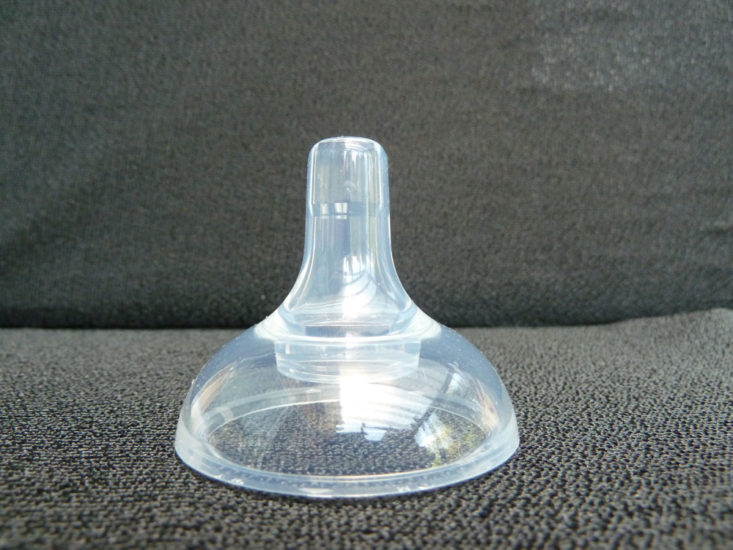There is a vast selection of bottles and teats available online or in the High Street. Many of them claim to be closer to breastfeeding in some way, whether it is the shape or size of the teat, the rate of flow of milk, the softness of the material or something about the sucking mechanism. Unfortunately, most of these claims are poorly researched and simply a ploy to increase sales. Although there is no single “best bottle” for breastfeeding, and we can’t rely on advertising claims, there are certain bottle teat characteristics that are thought to help preserve a baby’s breastfeeding technique.
This article discusses pros and cons of a selection of newborn teat shapes with respect to how they might influence breastfeeding. The information should be read alongside Tips to Bottle Feed a Breastfed Baby and try to check customer reviews from other breastfeeding mothers before you buy.
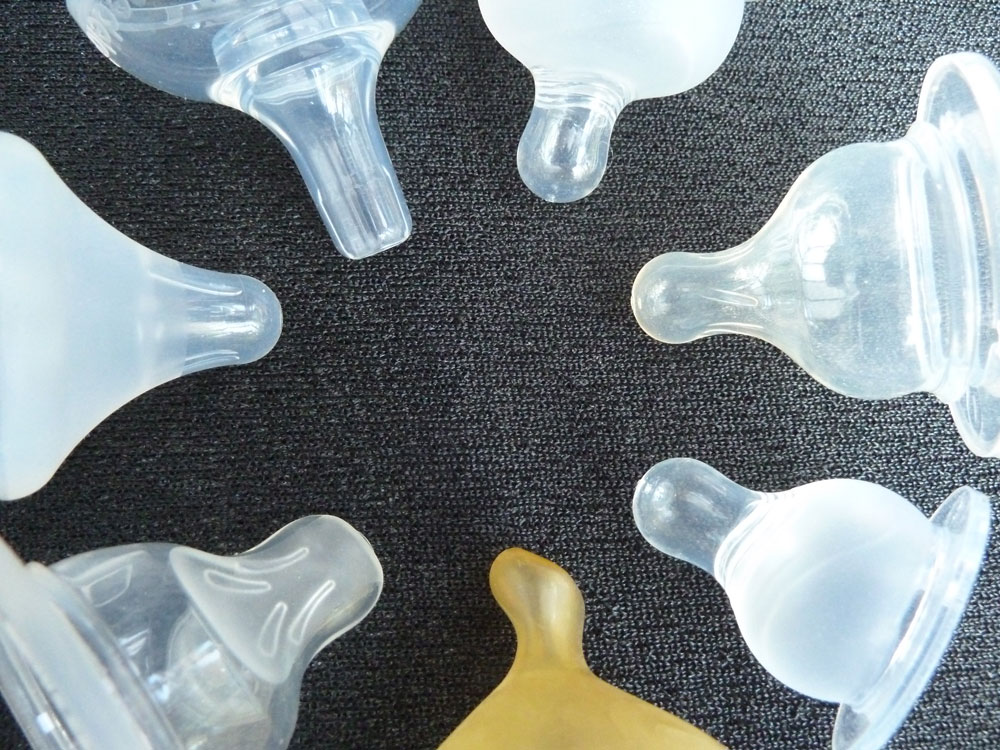
The aim of the game
When choosing a bottle teat for a breastfed baby, the goal is to try to recreate the same mouth position and tongue action with the bottle that your baby uses at the breast:
A short or medium length bottle teat with a rounded tip and a medium-wide base can allow a baby to take most of the bottle teat in his mouth close to the screw cap. This will give him a wide open mouth around the base of the bottle teat and the tip of the teat will be deep in his mouth in the same position as the nipple during breastfeeding.
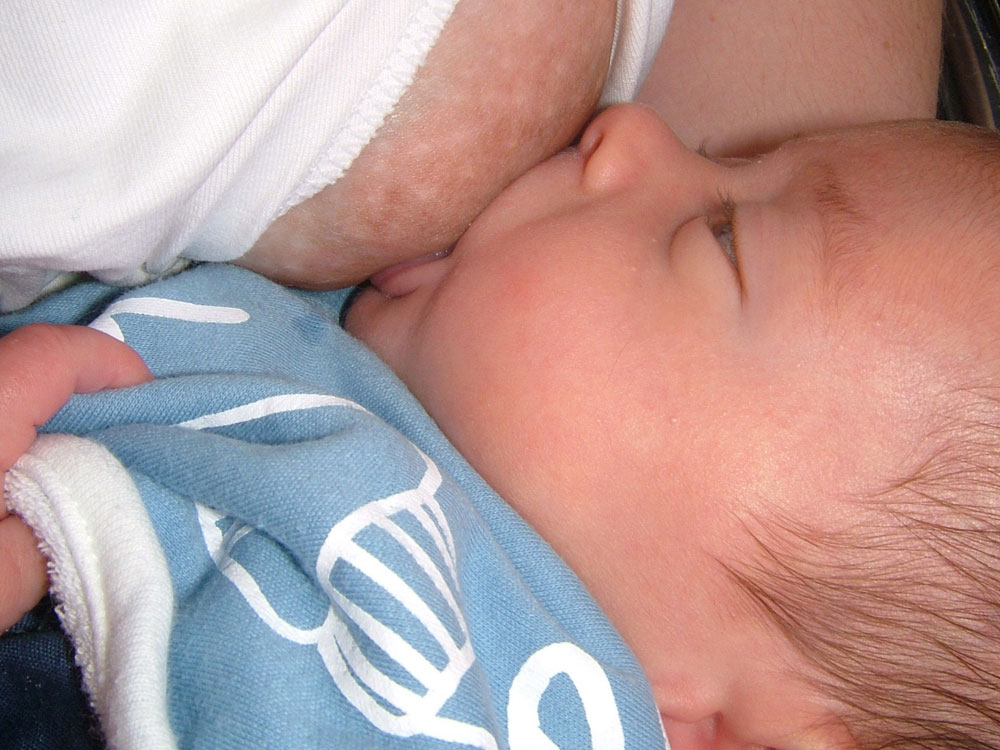
Comparing bottle teats
Expensive branded teats with fancy packaging are not necessarily any better than cheaper unbranded makes. Many lactation consultants recommend starting with a cheaper teat to see how that works before spending more money on expensive brands.
#1 The wide based bottle teat
A popular choice with manufacturers is to make a bottle teat that looks like a breast i.e. a short teat protrudes from a wide base. However, when the angle between the nipple of the teat and base is very steep, it makes it more difficult for a baby to make a wide mouth on the teat because they can slip off it and be forced to make a narrow mouth on the nipple tip. If the artificial teat is also made of a relatively inflexible or rigid silicone, this will be even harder for the baby to shape and hold with their tongue and will feel very different to a breast. The particular teat photographed has multiple rings of ridges on the inside surface of the nipple base which will make it more difficult to keep clean.
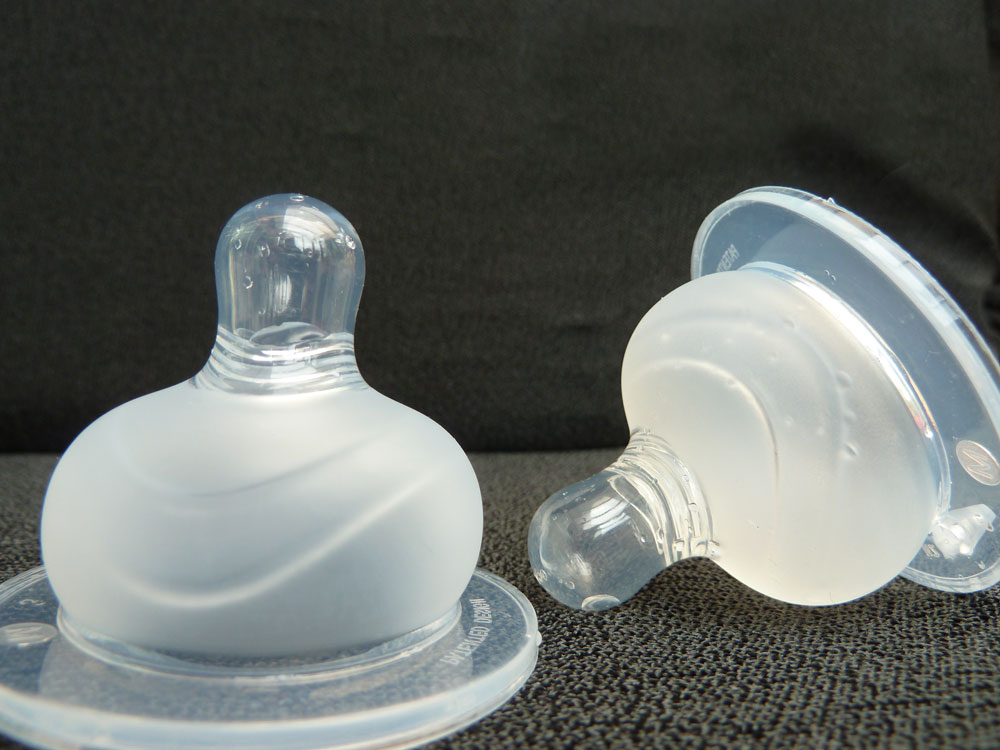
#2 The long narrow nipple
Some bottle teats have a very long nipple compared to the base. If the length of the nipple is too long this might be longer than a newborn baby’s mouth possibly making them gag. If the nipple is too long, it will also prevent the baby opening their mouth wide on the base of the teat. Whether this style will suit your baby will depend on the gradient between nipple and base, the size of your baby’s mouth, and the height of the teat. The greater the number of parts inside the teat, the more difficult it will be to keep clean.
#3 The small based teat
When the base of the teat is very small, the contrast between the nipple and the base of the teat will be less severe. A baby is more likely to be able to get both the nipple and base in his mouth up to the screw cap to mimic a deep latch (attachment) at the breast, however, if the base is too small, this will result in a smaller gape. Also be aware with small teats that if the total height is too short it might not reach deep enough into baby’s mouth to mimic the correct position for breastfeeding and may encourage a shallow latch when baby returns to the breast. Ideally the material used for the teat will not be too soft that it collapses in baby’s mouth, nor too rigid.
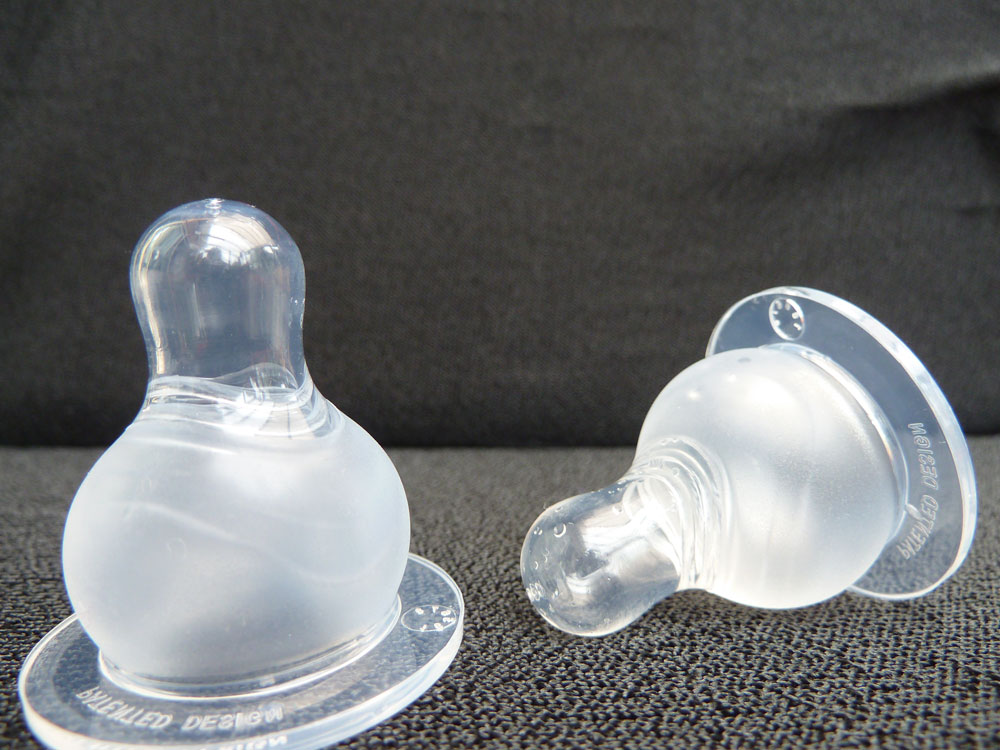
#4 The very soft teat
Some teats are made of very soft material. The teats in the following pictures are made of latex and have a slanted nipple tip. The softness of this type of teat has proved popular with premature babies or babies with neurological issues who are having difficulties with a regular teat. However if the teat is so soft that it collapses in baby’s mouth when they feed, this can create a very closed, clenched mouth position which is not desirable for breastfeeding. Slanted or “orthodontic” bottle nipples may cause a baby to retract and hump the back of his tongue during bottle feeding which if repeated at the breast could reduce milk transfer and compress the mother’s nipple.1 A mother’s nipple should not be compressed or distorted during a feed—since this can lead to pain, soreness or vasospasm.
Latex is an allergenic material and some babies could be allergic to latex.2
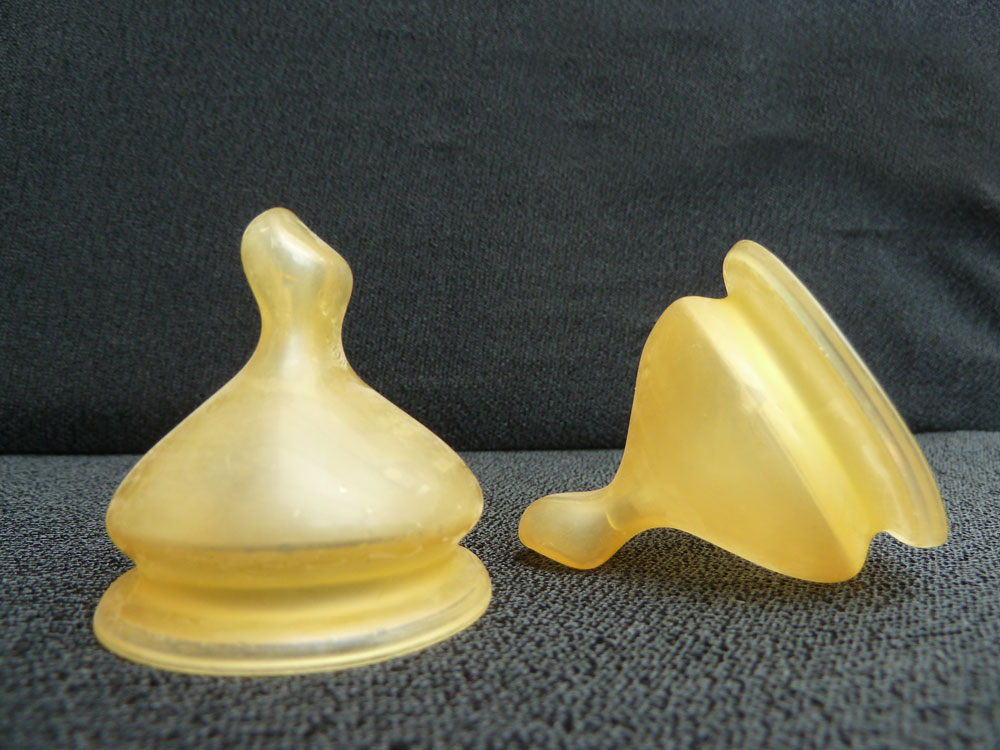

#5 The flattened teat
If a teat is sculptured on two opposite sides it will create a slightly flattened, angular teat. Depending how deeply a baby can take the teat in their mouth the flattened shape may prove difficult for baby to get a good seal with his lips and the edges of the sculptured areas could contribute to lip blisters. However if the silicone material is soft and the sides are not too steeply graded with a medium wide base, this style may suit some babies.

#6 The medium based teat with a medium height nipple
The medium based teat with a short to medium height nipple is a shape thought to work well for a breastfed baby. Success will vary depending on the softness of the material used for the teat (not too firm, not too soft), the gradient between nipple and base, and the size of your baby’s mouth.
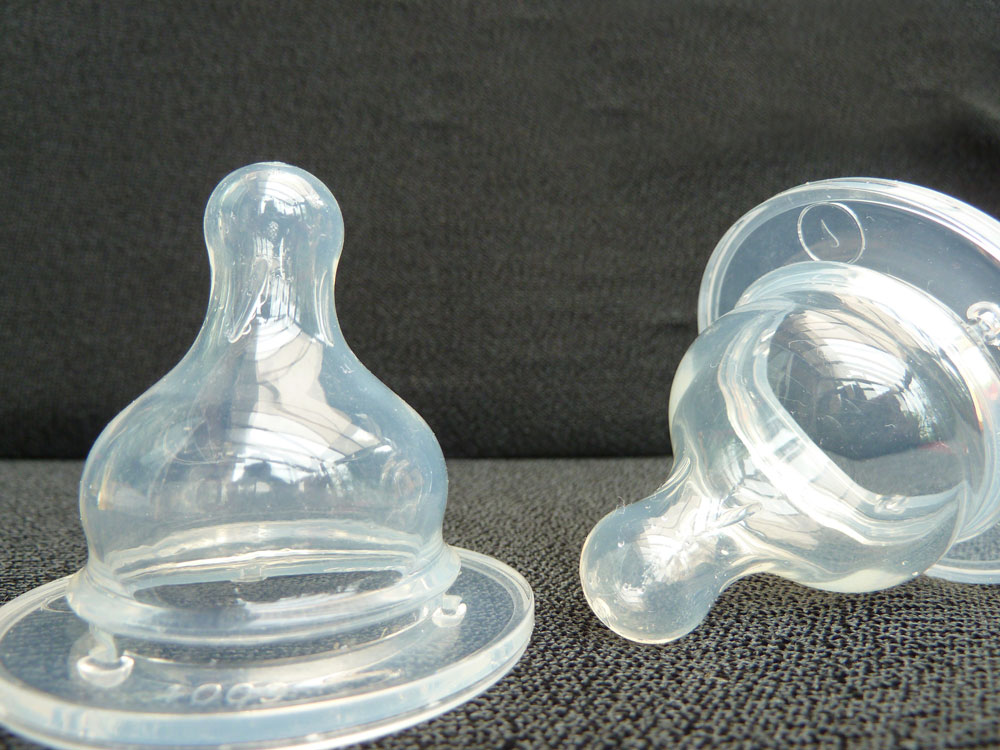
#7 The gently sloping teat
Some bottle teats do not have a clearly defined difference between the nipple and the base, they look more like a nipple shield. Depending on the slope between nipple and base and the height of the teat, this shape could allow a baby to have a wide open mouth on the teat base to recreate the deep latch position desired in breastfeeding. According to reviews, some mothers found their breastfed babies accepted these when they refused other bottle teat shapes.

What about the bottle?
The bottle shape and size are not as important to preserving breastfeeding technique as the bottle teat. However the size of the bottle is worth considering. Some bottles have a very large capacity e.g. 260ml (9oz) or 330ml (11oz) yet a newborn breastfed baby typically does not take anything like these volumes at each feed. In the first few weeks, volumes per feed might be around 60-80ml (2-3oz) and between one month and six months of age, it is estimated that breastfed babies take an average 89-148ml (3-5oz) per feed 3. Smaller capacity bottles (e.g. 150ml/5oz) will give a more realistic estimate of both your baby’s appetite and the volume of breast milk you might expect to pump in one go. See Tips to Bottle Feed a Breastfed Baby for ideas to help control the flow of milk to your baby to resemble what happens during breastfeeding.
Cleaning bottles and teats
Bottle feeding equipment needs to be kept scrupulously clean to avoid being an infection hazard. Ridges, crevices and internal parts in teats make them much more difficult to keep clean. See Sterilising Baby Bottles (National Health Service website, 2019) for comprehensive information on how to clean your baby’s feeding equipment.
Alternatives to bottle feeding?
When introducing bottles to your breastfed baby, there is a risk that your baby could start to prefer a bottle teat over the breast (sometimes called nipple confusion or bottle preference) and this could undermine breastfeeding. Particularly if the reasons they are having bottle feeds are to do with difficulties breastfeeding or low milk supply. While the choice of teat shape and our Tips to Bottle Feed a Breastfed Baby can help to minimise problems, there are other feeding methods to consider such as Cup Feeding, or Breastfeeding With a Supplemental Nursing System. An IBCLC lactation consultant can help you decide on the best choice of feeding method for your baby’s situation.
Low milk supply?
If you are struggling with low milk supply, contacting an IBCLC lactation consultant or other breastfeeding specialist for help can be invaluable, and see How to Make More Breast Milk. If you’re considering using industrially made milks, Supplementing With Formula includes information on preparing formula safely and answers other frequently asked questions.
Summary
There are many different bottle teat shapes made of different materials with differing flexibility and flow rates. Manufacturers’ statements that their bottles are “closer to breastfeeding” are just marketing claims designed to sell their products. Expensive brands are not necessarily better than cheap ones. Certain features of a bottle teat such as the length of teat, or width of the base can help mimic breastfeeding more closely. Babies come in different shapes and sizes with different sucking skills so one teat is not going to suit all babies making it difficult to recommend specific brands. Parents may have to try a few different styles to find the best bottle teat for their baby that doesn’t seem to interfere with breastfeeding, and recreates the same open mouth position needed at the breast. A helpful shape will likely be a medium wide base and a short to medium nipple or one with a gradual slope between the tip and base of the teat.4
Using bottles could undermine breastfeeding for some babies and cup feeding or supplementing at the breast are other feeding options to consider. This article should be read in conjunction with Tips to Bottle Feed a Breastfed Baby.
